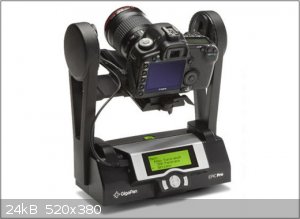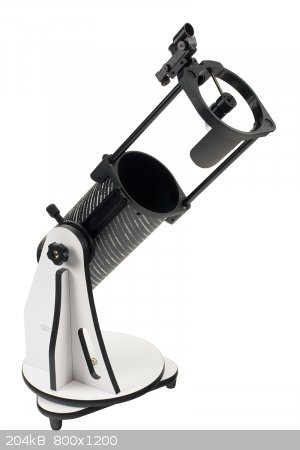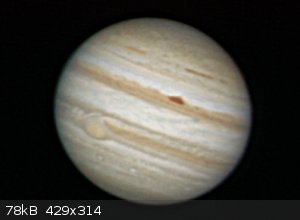RogueRose
International Hazard
    
Posts: 1585
Registered: 16-6-2014
Member Is Offline
|
|
Robotics - building an dual axis (X,Y) camera mount
I don't know if anyone is interested in robotics here, but I thought there may be some others interested in this as well, so I thought I would post.
It is sciencey.
I've been looking into robotics as it is another area of interest of mine as it involves electronics, computers and videography. I want to make a
very sturdy telescope & camera mount that can pan and tilt, ideally 360 and 180 vertical (though 135 would probably be fine).
I'm looking at something like this:

While it wouldn't look like this, I envision the basic design to be similar, with a large motorized base (larger than this) and then two vertical
gears/joints that can allow for tilt and keep the scope very steady.
The most confusing is deciding what kind of motors to use from stepper, servo's, brushless, brushed, etc. IDK if anyone has taken apart a printer
(inkjet or laser) but they have a clear disc that has measurements on it like a ruler and the measurements are counted to determine position. They
also use a linear plastic strip with markers for determinig horizontal position of the inkjet. Something similar may be used in CNC machines as well.
I'm considering using something like this in combination with a stepper/servo (both probably geared down for greater accuracy and higher torque).
I'm planning on incorperating a video location camera in addition to the main scope/video camera to act as the positioning finder. It will be fixed
and not move, and a point on the screen can be selected and the camera/scope moves to that point on the fixed screen. Then the camera can record
(zoomed in) the imagery.
I've tried to find some good forums on robotics and have been a little disappointed and pickings have been a little slim. IDK if this has to do with
lack of material or due to google searches (seems search results have been more commercial lately).
I found this site which has some good info, a lot is repeated though.
http://www.societyofrobots.com/robotforum/index.php?board=5....
Anyone have any experience with this, know of any good sites/forums/blogs/etc? Or have a suggestion on motor selection (type)?
|
|
|
Twospoons
International Hazard
    
Posts: 1282
Registered: 26-7-2004
Location: Middle Earth
Member Is Offline
Mood: A trace of hope...
|
|
I'd go steppers with a microstepping driver, then you only need a home switch instead of encoders. If you do want encoders then Austrian Micro Systems do a range of magnetic encoders - up to 14bit rotary.
Helicopter: "helico" -> spiral, "pter" -> with wings
|
|
|
wg48
National Hazard
   
Posts: 821
Registered: 21-11-2015
Member Is Offline
Mood: No Mood
|
|
The details of such a system depends on the accuracy, speed, stability you want to achieve and the mass/inertia of the telescope/mirror you want to
slew a round. One I designed and built could point anywhere in a hemisphere in no more than 100ms with sub miliradian accuracy and an rms stability
approaching a few microradian. But it was expensive very expensive. Even more expensive if you want to do it on a moving vehicle especially if its a
jet aircraft. (Sorry for the blatant crowing).
|
|
|
Sulaiman
International Hazard
    
Posts: 3558
Registered: 8-2-2015
Location: 3rd rock from the sun
Member Is Offline
|
|
It may be cheaper to buy a used motorised telescope mount via eBay etc than DIY.
Or maybe Thingyverse has pan-tilt or alt. az. designs to justify you buying a 3D printer ?
wg48: I worked on optical encoders for aiming the gun on tanks whilst travelling over rough terrain in the '70's 
[Edited on 7-4-2018 by Sulaiman]
CAUTION : Hobby Chemist, not Professional or even Amateur
|
|
|
wg48
National Hazard
   
Posts: 821
Registered: 21-11-2015
Member Is Offline
Mood: No Mood
|
|
Quote: Originally posted by Sulaiman  | It may be cheaper to buy a used motorised telescope mount via eBay etc than DIY.
Or maybe Thingyverse has pan-tilt or alt. az. designs to justify you buying a 3D printer ?
wg48: I worked on optical encoders for aiming the gun on tanks whilst travelling over rough terrain in the '70's 
[Edited on 7-4-2018 by Sulaiman] |
I mostly worked on optical pointing systems. Because of the worries about dust, contamination and accuracy we used industosyns (essentially muti pairs
of single turn coils printed on two flat discs) for angle measurment. Even when energised at 10kHz the pick up coil’s outputs were still only mVs.
Getting 19 bit angular resolutions out of such small signals was tricky and only possible using coarse (1 cycle) and fine (multi cycle) inductosyns,
synchronous converters and excellent screening and grounding practices.
|
|
|
RogueRose
International Hazard
    
Posts: 1585
Registered: 16-6-2014
Member Is Offline
|
|
wg48 - thanks for the mention of inductosyn's, I didn't know what they were called but I thought about building something similar on a PCB and use
something like a wire brush or a graphite brush to count the "ticks". I'm still trying to figure out what the optical version of these are called,
the things they use on printers in either a disc or linear strip (both printed on cleat plastic).
As far as requirements (size/weight/speed), I'd like to build it larger than needed if possible as I've found some VERY good deals on used scopes and
they look to be pretty heavy. Motor ratings aren't what I'm focusing on ATM, more design now.
I'm planning on having a fixed camera as an optical view finder attached to a monitor (let's say 3840 pixels × 2160 - which is UHD an maybe
eventually 7680 pixels × 4320 if higher resolution/accuracy is ever necessary) and then a pointing device to select the area of focus/tracking.
Using the monitor pixel's as a grid, I plan to calibrate the motors (repetitive learning process of different voltages and pulse width's) to learn
the amount of "energy" (voltage & current time or pulses) needed to move X distance on both X and Y axis (each axis learned independently &
when synchronized). I don't know if I can use the "learning process" along with inductosyns (or optical) to get more accuracy.
As for motors I was thinking of either using very high speed servo's so that some number of turns = 1 pixel, possibly geared down. The other options
are stepper or BLDC. I'm thinking that BLDC will give me the highest power/weight ratio while the servo's will be the easiest to calibrate.
my idea for using BLDC would be to have a power supply capable of a number of voltages to supply something like 100%, 90%, 80%, 70% of normal voltage
and then allow the power to turn on for various durations in millisecond lengths - then run tests that will calculate the time needed for X/Y travel
at the various power levels. Probably adding a measurement device like an inductosyn or rotary optical encoder.
|
|
|
Sulaiman
International Hazard
    
Posts: 3558
Registered: 8-2-2015
Location: 3rd rock from the sun
Member Is Offline
|
|
If you use a d.c. motor (or any motor other than synchronous or stepper)
then you will have to use positional feedback,
as applying a fixed power for a fixed time will not give a fixed change in angle,
due to changes in balance, friction, temperature ..........
---------------------------------------------------------------
For astrophotography the mount has two purposes,
1) To move the telescope to point at a particular area of space, by adjusting polar coordinates relative to earth
2) To compensate for the rotation of the earth.
The most important is #2
because #1 could be an entirely manual process.
----------------------------------------------------------------
Look at the specifications for the type of telescope that you want to buy,
most important is the angular resolution (size of 'Airy disk'),
the tracking of the mount should have similar or better angular resolution.
----------------------------------------------------------------
If you live in a city, divide your expectations by one or two orders of magnitude 
due to light pollution, haze, heated air currents etc.
----------------------------------------------------------------
I'm a part-time amateur astronomer,
my favourite telescope is my diy 60mm refractor,
because I got a spectacle lens maker to grind the objective for me (9:1 curvature ratio for low coma)
- following Galileo Galilei (who stole the idea from Hans Lippershey)
I also have a commercial refractor and a reflector.
In general, a hobby 'scope will cost about the same as a suitable go-to motorised mount.
------------------------------------------------------------------
Here are two reasons for NOT doing amateur astronomy
1) The best views are during the early hours of freezing cold winter mornings,
you will freeze-off all of your delicate bits, then be tired at work/school etc.
2) You will always want a better/costlier 'scope, mount, camera, eyepiece, filter ....
I suggest that you join your local astronomy club;
. use club/members 'scopes to see if you develop a genuine interrest
. buy a used 'scope from a member - most have generations of 'scopes.
As there is very little for an amateur astronomer to discover, it's mainly just a matter of looking in awe,
for which a good pair of binoculars is probably the best equipment.
Personally my astronomy interest has waned, I now mostly look at
meteor showers, moon, sun (via a filter) and ISS,
for deep space and planets I rely on NASA photo's.
Once you have seen Saturn and Jupiter a couple of times you will get bored as you need a good telescope, mount and location to get even a little
detail.
The other planets are even more boring.
P.S. My prediction is that you will get very excited and involved with astronomy - for a while,
after that,
- it is much easier to sell a used commercial mount than a diy mount.
P.P.S. Do not waste money on APO 'scopes, very cute but poor value.
Do waste money on one or two good eyepieces, the difference is amazing.
[Edited on 8-4-2018 by Sulaiman]
CAUTION : Hobby Chemist, not Professional or even Amateur
|
|
|
LearnedAmateur
National Hazard
   
Posts: 513
Registered: 30-3-2017
Location: Somewhere in the UK
Member Is Offline
Mood: Free Radical
|
|
Talking about telescopes since my knowledge of electronics could be improved, I get some lovely shots through my 130mm Dobsonian - shorter than your
stereotypical telescope but a lot more bulky. Saturn and Jupiter + their moons, the Moon with very fine detail - especially cool if you can get a
plane or the ISS passing between. Mars (when reflective glare permits but it’s actually harder to see detail than further planets), basic shots of
Venus, Andromeda with minimal light pollution, and various features like clusters and other galaxies if your eye is keen.
Surely with these designs it should be relatively simple to set up a motor system where the rotation points are on the scope mount and base? I should
be getting a new telescope at some point in the foreseeable future so I’d have no need.

In chemistry, sometimes the solution is the problem.
It’s been a while, but I’m not dead! Updated 7/1/2020. Shout out to Aga, we got along well.
|
|
|
wg48
National Hazard
   
Posts: 821
Registered: 21-11-2015
Member Is Offline
Mood: No Mood
|
|
This thread reminded me of my father’s transistor electronic synchronous motor drive he built for his friends telescope about 60 years ago.
Apparently the advantage was the simple gear ratios required to track the moon and stares compared to using the mains 50Hz.
I was curious as to what sort of pointing stability is required for an armature telescope. The picture below is an incredible (to me) armature pic of
Jupiter taken at opposition. At that time Jupiter subtends about 50 arcseconds or as I prefer 250urad. So that pic would require sub microradian
stability (<1urad)

The incredible pic was taken by Robert J. Vanderbei. For more pics and details of his equipment see:
http://www.princeton.edu/~rvdb/images/NJP/jupiter.html
|
|
|